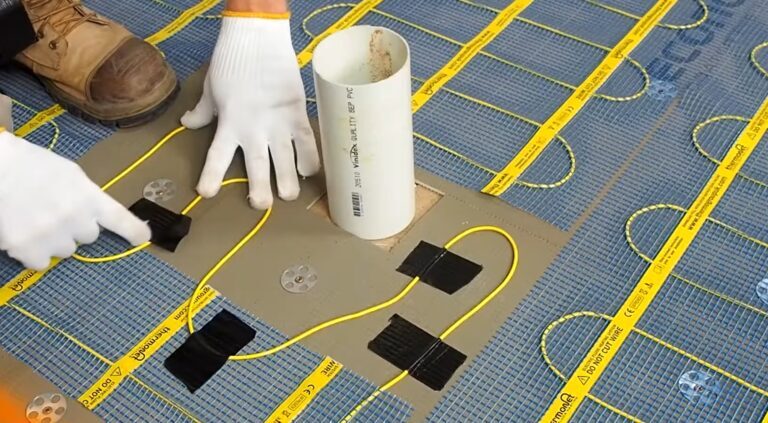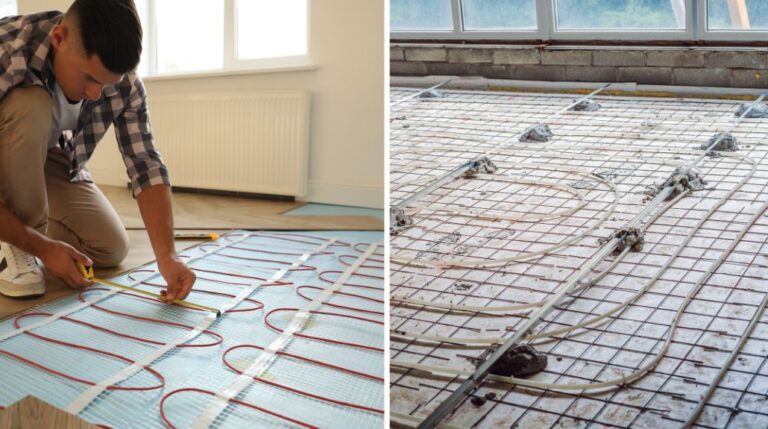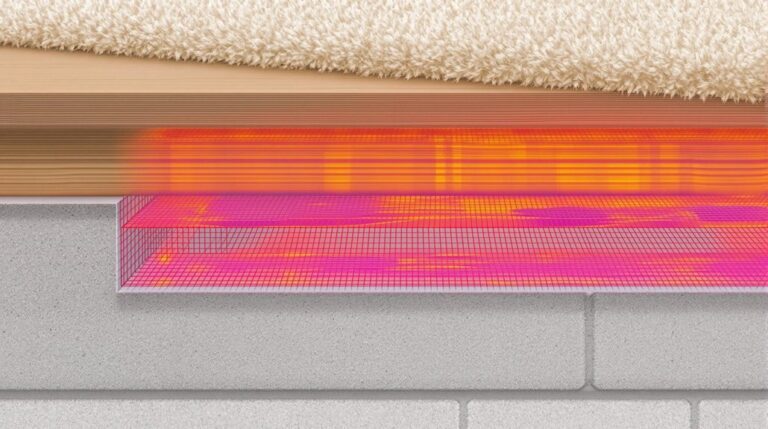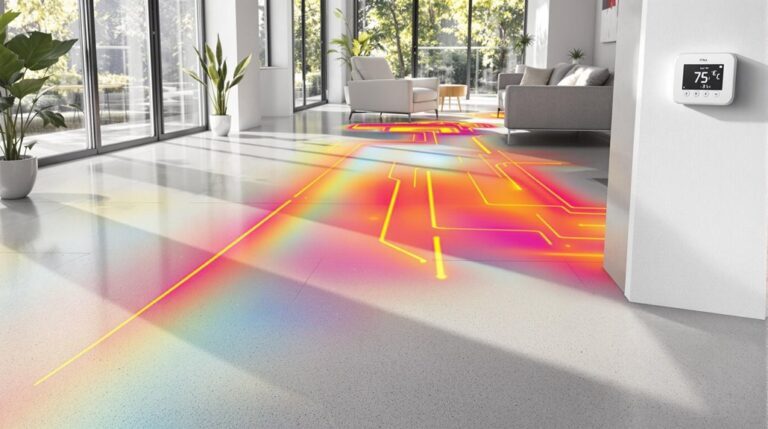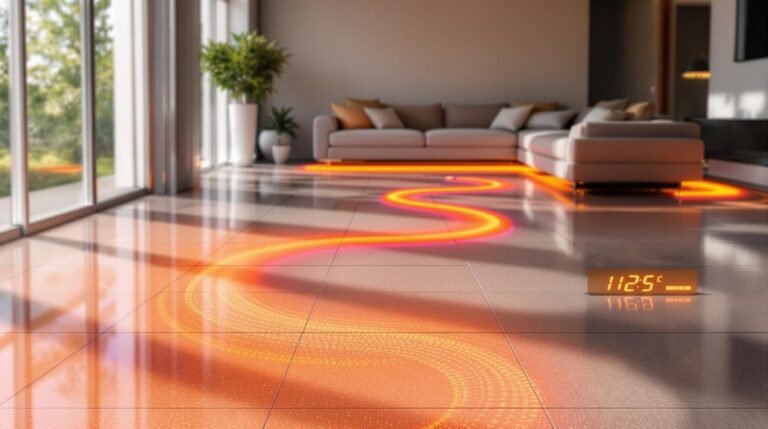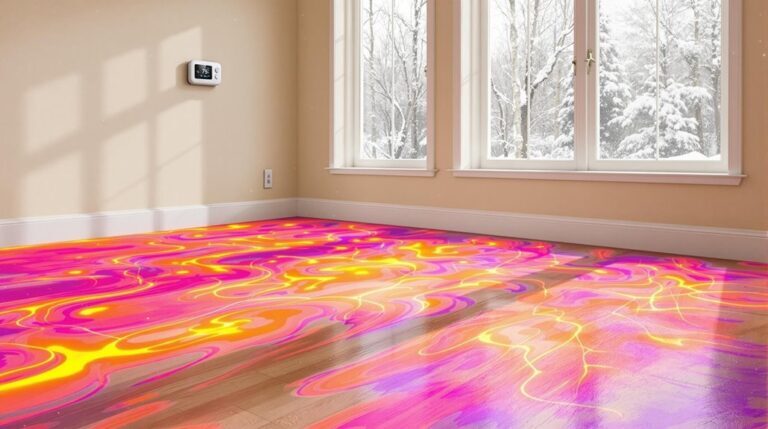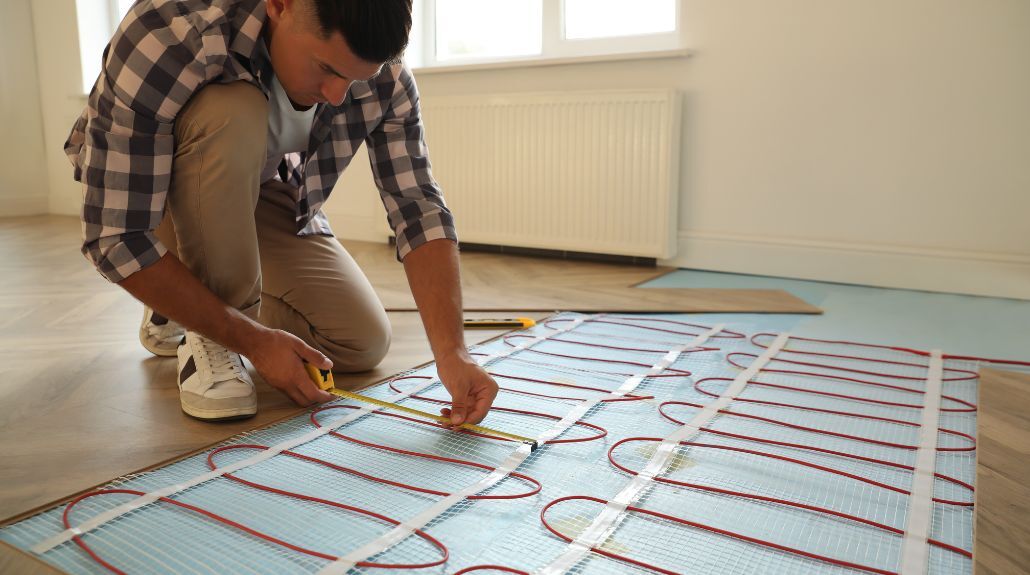
You might wonder if the gentle, consistent warmth you feel from heated floors really can be more efficient than traditional radiators. The truth is that underfloor heating systems operate on a simple yet ingenious principle of radiant heat distribution, warming your living space from the ground up. Unlike conventional heating methods that create pockets of hot and cold air, underfloor systems work by turning your entire floor into a radiating surface. While the concept seems straightforward, understanding how these systems achieve such uniform comfort involves exploring several key mechanisms that make this technology increasingly popular in modern homes.
Key Takeaways
- Underfloor heating uses either warm water pipes (hydronic) or electric cables installed beneath flooring to radiate heat upwards through the floor.
- The system heats the entire floor surface evenly at lower temperatures (35-40°C), warming objects and people directly rather than heating air.
- Pipes or cables are laid in specific patterns with consistent spacing to ensure uniform heat distribution throughout rooms.
- A control system with thermostats regulates temperature room by room, maintaining optimal comfort levels up to 27°C maximum.
- Insulation beneath the heating elements prevents downward heat loss, directing warmth upward for efficient room heating.
How Underfloor Heating Systems Work: A Comprehensive Overview
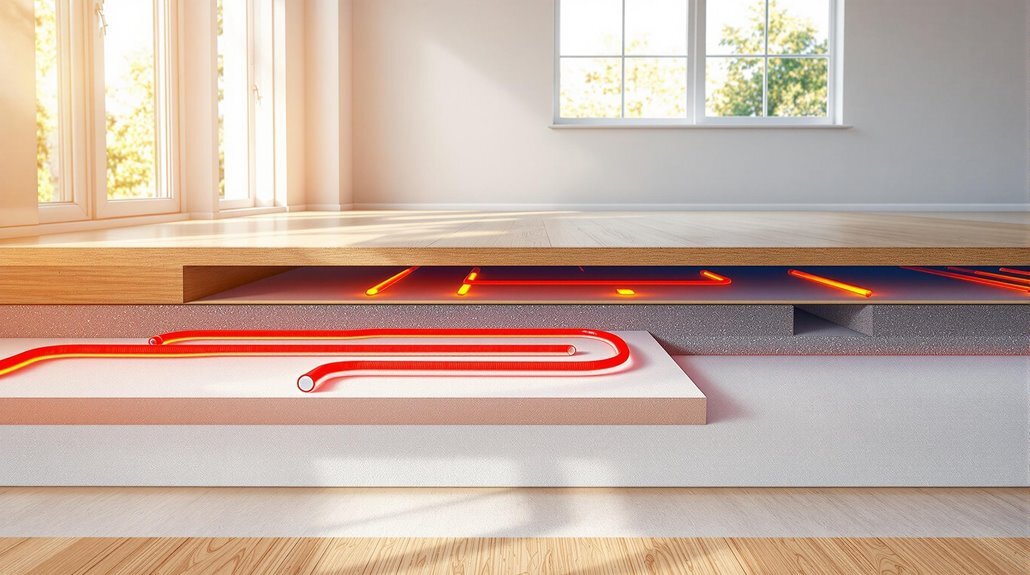
Australia’s growing interest in underfloor heating systems has transformed how we think about home comfort. At Floor Heating Today, we’ve seen firsthand how Sydney homeowners are embracing this innovative heating solution, and we’re here to explain how these systems work to keep your home cozy.
There are two main types of underfloor heating you can choose from: hydronic systems and electric systems. Hydronic systems work by circulating warm water through a network of pipes installed beneath your floor. These systems are particularly efficient for larger spaces and can be powered by various heat sources, including boilers, solar panels, and heat pumps.
Electric systems, on the other hand, use heating cables or mats placed under your flooring. They’re often preferred for renovation projects because they’re easier to install and maintain. Both systems are controlled by thermostats that let you manage temperature settings room by room, giving you precise control over your home’s comfort levels.
The installation process varies between the two systems. Hydronic systems typically require more extensive work and are best suited for new builds or major renovations. They need careful planning to guarantee proper pipe layout and connection to your heat source.
Electric systems are more straightforward to install, though they still require professional expertise to guarantee proper insulation and even heat distribution.
At our company, we’ve found that understanding these basics helps our clients make informed decisions about which system best suits their needs. Whether you’re building new or renovating, underfloor heating offers an efficient, comfortable heating solution for your Sydney home.
Essential Components That Make Floor Heating Work Efficiently
The seamless operation of underfloor heating relies on four essential components working together in harmony: thermostats, control packs with manifolds, wiring centres, and pipe circuits.
Let’s start with your thermostats – they’re the brains of the operation. They’ll regulate temperatures in each room or zone of your home, telling the system when heating is needed and at what temperature. Today’s smart thermostats can be programmed for maximum energy efficiency, guaranteeing you’re only using heat when you need it.
Your underfloor heating control pack and manifold work as the system’s distribution centre. They take warm water from your heat source and mix it to the ideal temperature (around 50°C) before sending it through various pipe circuits under your floor.
The manifold includes flow meters that let you adjust water flow rates and features convenient maintenance points for air venting and system drainage.
The wiring centre acts as your system’s central nervous system, coordinating all components through a single connection point. It manages the switching of zone actuators, control pack, and boiler, enabling separate zone control through voltage-free heat demand relays.
Finally, pipe circuits are the workhorses of your heating system. These durable polyethylene pipes distribute warm water throughout your floor, heating it to a comfortable 25-28°C.
They’re secured using various fixing methods and paired with insulation to prevent heat loss and direct warmth upward. This combination guarantees even heat distribution across your entire floor surface, creating that perfect, cozy environment you’re looking for.
Exploring Different Types of Underfloor Heating Systems: Electric & Hydronic
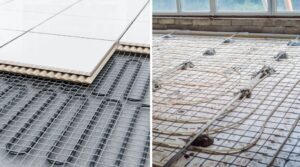
Today’s underfloor heating systems come in two distinct varieties: wet systems that circulate warm water through pipes, and electric systems that use heating mats or cables.
Wet systems connect to your boiler or heat pump and circulate warm water through a network of pipes. You’ll find these pipes either buried in floor screed or mounted within insulated panels.
They’re particularly energy efficient and work wonderfully with renewable technologies. If you’re building a new home or planning a major renovation, wet systems offer the most cost-effective long-term solution, though they’ll require professional installation and new floor screeding.
Electric systems, on the other hand, are your go-to choice for renovation projects. They’re available as ultra-thin heating mats for regular-shaped rooms or flexible cables for spaces with unusual layouts.
You won’t need to worry about raising floor levels considerably, as these systems can be installed directly over your existing subfloor. While they might’ve higher running costs than wet systems, they’re quicker to install and offer excellent room-by-room control.
Both types of underfloor heating can transform your home’s comfort level. You’ll benefit from even heat distribution and can control different zones independently using smart thermostats.
We’ve installed hundreds of systems across Sydney, and we’ve found that wet systems typically suit whole-house installations, while electric systems are perfect for single-room upgrades like bathrooms or kitchens.
Your choice will ultimately depend on your property type, renovation scope, and heating needs.
The Science Behind Radiant Heat and How It Powers Underfloor Heating
Understanding radiant heat is essential to appreciating why underfloor heating works so efficiently. Unlike traditional heating systems that rely on moving air, radiant heat transfer mechanism works through electromagnetic waves, similar to how you feel the sun’s warmth on your skin. This means the heat travels directly from your floor to objects and people in the room without losing energy along the way.
When you install underfloor heating, you’re taking advantage of one of nature’s most efficient heating methods. The system warms the floor surface, which then emits infrared radiation upward throughout your space. Since heat naturally rises, this creates an ideal temperature distribution from floor to ceiling.
What’s particularly impressive is that radiant heat doesn’t need air as a medium to transfer warmth, which means you’ll feel comfortable even at lower air temperatures.
The energy savings from this approach are significant. At Floor Heating Today, we’ve seen our Sydney customers reduce their heating costs by up to 25% compared to traditional radiators, and even more when they combine their systems with heat pumps.
This efficiency comes from the fact that radiant heat warms objects and surfaces directly, rather than wasting energy heating air that rises to the ceiling. Plus, since underfloor heating operates at lower temperatures while providing the same comfort level, it requires less energy input overall.
The system’s immediate reaction time and ability to maintain consistent temperatures make it an incredibly efficient choice for Australian homes.
The Installation Process of Electric Underfloor Heating in Your Home
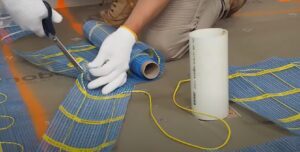
After seeing how effectively radiant heat works, many of our Sydney clients ask about the installation process. At Floor Heating Today, we follow a systematic approach that begins with thorough installation preparation.
We start by cleaning the subfloor and installing a damp-proof membrane to protect against moisture. Next, we lay down insulation boards with taped seams to maximize heat efficiency.
The next phase involves manifold installation, which serves as the control center for your underfloor heating system. We carefully select a prime location for the manifold and secure it firmly to a sturdy wall.
Then comes pipe laying, where we snake the pipes from the manifold across your floor in a specific pattern, maintaining 20cm spacing between runs for even heat distribution. For larger rooms, we install multiple loops to guarantee extensive coverage.
Pressure testing is vital to verify system integrity. We maintain pressure in the pipes while laying the screed to prevent compression issues and detect any potential leaks.
The pipes remain filled with water throughout this process, allowing us to quickly identify and address any damage that might occur during screeding.
The final stage involves connecting your system to power sources and controls. We complete the thermostat connection, linking it to the wiring centre that manages your heating zones.
This setup enables precise temperature control in different areas of your home. Once we’ve verified all connections and tested the system thoroughly, your underfloor heating is ready to provide efficient, comfortable warmth throughout your space.
Control and Temperature Management for Efficient Floor Heating Systems
Precise temperature control stands at the heart of an efficient underfloor heating system. At Floor Heating Today, we’ve seen how modern controls have revolutionized the way homeowners manage their heating. You’ll find various options, from basic manual thermostats to advanced smart systems that integrate seamlessly with your home automation setup.
Today’s thermostats offer far more than simple on/off functionality. You can program specific temperature settings for different times of the day, and smart thermostats even learn your preferences over time. Temperature management is essential – we recommend keeping the maximum temperature at 27°C to protect your flooring and guarantee peak performance.
Smart thermostats are particularly valuable for Sydney homeowners looking to maximize energy-saving potential. You can control your system remotely through smartphone apps, allowing you to adjust settings while you’re away from home.
These advanced controls also offer automated features that can predict when to start heating to reach your desired temperature at the right time.
When selecting your control system, you’ll need to take into account whether you have an electric or hydronic system, as different thermostats are designed for specific installations.
We recommend opting for controls that measure both floor and air temperature for the most accurate readings. If you’re interested in voice activation, many of our smart thermostats integrate with popular home assistants, making it even easier to maintain your perfect comfort level while enhancing energy efficiency.
Cost and Energy Considerations for Hydronic and Electric Underfloor Heating
Many homeowners ask us about the financial aspects of underfloor heating, and we’re always transparent about both costs and potential savings. At Floor Heating Today, we find that installation costs typically range from $7 to $17 per square foot for basic systems, while whole-house installations can range from $10,000 to $34,000, depending on your home’s size and the system type you choose.
The good news is that underfloor heating systems are incredibly energy efficient, using 15-40% less energy than traditional radiator systems. You’ll find that they operate at lower temperatures (around 35°C) compared to conventional radiators (70-80°C), which contributes to significant energy savings over time.
We’ve seen that proper installation with correct pipework spacing and insulation boards can reduce running costs by up to 50%.
When considering running costs, it’s important to understand that several factors affect your energy consumption. Your home’s insulation, thermostat settings, and local climate all play essential roles. We recommend programmable thermostats to optimize efficiency and reduce unnecessary heating.
Electric systems are particularly efficient compared to forced air systems, offering more uniform heat distribution and reduced operating times.
For those interested in alternative options, we offer solar and geothermal systems. While these have higher installation costs ($8,000 to $69,000 depending on the system), they typically provide better long-term cost benefits.
Propane systems remain our most affordable option, with costs between $2,400 and $2,900, making them an attractive choice for budget-conscious homeowners.
Maintenance and Troubleshooting Tips for Effective Heating and Cooling Systems
Drawing from our extensive experience at Floor Heating Today, we’ve found that proper maintenance is vital for keeping your underfloor heating system running efficiently. Regular inspections help identify potential issues before they become major problems, saving you time and money in the long run.
To maintain your system effectively, you’ll need to perform several key tasks. First, check your thermostat regularly to verify it’s functioning correctly and maintaining your desired temperature. If you notice inconsistent heating patterns, this could indicate a problem with your thermostat settings or batteries.
You’ll also want to inspect for any damage to your floor covering, as this can affect heat distribution.
When troubleshooting common issues, start by checking for non-heating zones, which often result from air bubbles in the system or faulty actuators. If you notice pressure drops or unusual noises, you might’ve air trapped in the pipes. In this case, bleeding the system can resolve the issue.
For water-based systems, maintaining proper pressure is vital – sudden drops could indicate leaks that require immediate attention.
More complex problems, such as circulation pump failures or manifold issues, typically require professional intervention. At Floor Heating Today, we recommend calling a qualified technician if you encounter issues with stuck actuators, continuous pump operation, or system-wide heating failures.
Regular maintenance checks by professionals can help prevent these issues and verify your system continues to operate at peak efficiency.
Comparing Traditional Radiators vs Underfloor Heating Systems for Home Comfort
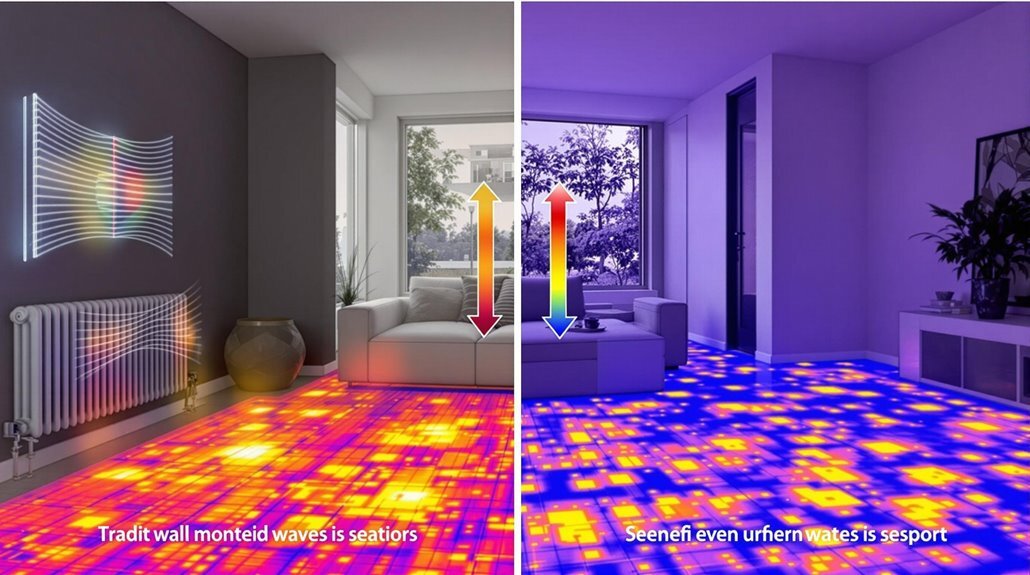
When comparing traditional central heating to underfloor heating, there are three essential differences you’ll need to take into account. The first is operating temperature – traditional central heating systems work at considerably higher temperatures (70°C-80°C) compared to underfloor heating (35°C-40°C). This difference directly impacts your energy consumption and running costs.
The second major difference is heat distribution. Underfloor heating works by warming your entire floor surface, which helps to evenly distribute heat throughout your room. Traditional radiators, on the other hand, create hot spots near the radiators and cold spots in areas further away, leading to less comfortable living spaces.
Let’s break down the key differences:
| Feature | Traditional Central Heating | Underfloor Heating |
|---|---|---|
| Energy Efficiency | Less efficient due to high operating temperatures | 25% more energy-efficient |
| Heat Distribution | Uneven with hot and cold spots | Even heat across the room |
| Space Usage | Requires wall-mounted radiators | No visible heating elements |
The third vital difference is system efficiency. At Floor Heating Today, we’ve found that heating systems using underfloor technology are considerably more energy-efficient than traditional methods. You’ll typically save between 15-40% on your energy bills compared to conventional heating systems. This efficiency comes from the lower operating temperatures and more effective heat distribution. Plus, you won’t lose valuable wall space to radiators, and you’ll experience reduced dust circulation throughout your home.
Contact Us for Expert Underfloor Heating Installation
Incorporating electric underfloor heating into your home offers an efficient and comfortable way to manage your home’s heating and cooling needs. With options like radiant floor heating and in-screed heating, you can enjoy consistent warmth throughout your space. Ideal for spaces such as bathrooms, electric floor heating minimizes the need for hot air systems, improving air quality and reducing reliance on bulky heaters. Electric heating ensures a reliable, cost-effective solution that lasts.
If you’re ready to experience the comfort of underfloor heating, contact Floor Heating Today for expert installation tailored to your home’s needs.


